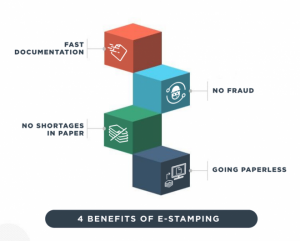E-Stamp paper or electronic stamp paper is an online application through which Stamp Duty can be safely paid to the Government. Government transactions need payment of non-judicial stamp duty. However, doing so in a conventional way would be a time-consuming process. Stamp papers are mostly used for creating rental agreements.
The law mandates that a certain amount has to be paid to the Central/State Govt. each time certain kinds of transactions take place. Such payments are referred to as Stamp duty. Examples of such transactions are buying and selling real estate, business agreements, leasing property, etc.
Stamp Duty is never paid in cash transactions. Instead, Stamp Papers equivalent to the payment value is purchased. Then the deed is printed/typed/written on it. Stamp papers evidently show that the required Stamp Duty has been paid to the Govt. It behaves similar to receipts.
The amount to be paid towards duty differs from state to state. In case a state does not possess its own Stamp Act, it will be overseen by the Indian Stamp Act.
The Backdrop of E-Stamping — How It Came About
In 2019, the Indian Stamp Act of 1899 was amended for the purpose of preventing tax evasion. The amendment was to be officially legislated from April 1, 2020. However, due to the outbreak of COVID–19 the amendment was delayed to 1st July 2020.
The process of E-Stamping is one of the simplest ways to fulfill an agreement. For this, a web portal is available where the payment for the stamp duty can be made. The e-SBTR (Electronic Secure Bank and Treasury Receipt) system enables E-Stamping for the authorized bank. This reduces time and other administrative expenses.
So What Is E-Stamping?
E-Stamping was launched to enhance the stamp duty payment method. Stock Holding Corporation of India Limited (“SHCIL”) is responsible for all the e-stamps utilized in the country. SHCIL is a body appointed by the Central Government. It is also responsible for the maintenance of records.
There are many advantages to using e-stamps. E-Stamping is basically tamper-proof. A unique identification number is generated to check the authenticity of the e-stamp.
There are drawbacks to e-stamping as well. For example, in the event of loss of the e-stamp certificate, then a duplicate copy cannot be issued. Another point is that despite online payment, the actual stamp paper has to be collected physically. This can be done from their respective vendors. It is a hassle and a major challenge in the current situation to collect the physical stamp paper.
Another consequent problem faced in e-stamping is a late fee. In such cases, a late fee will be levied. The Collector is the discretionary authority to accept delayed payments if an appropriate reason is given. This will be at his/her discretion.
An exception with regard to the late fee due to delayed payments is the Maharashtra Stamp Act. According to Section 17 of the Maharashtra Stamp Act, the stamp duty can be paid the next day after the execution.
On April 20, 2020, the Ministry of Finance appealed to the State Governments to issue proper instructions to the Collector. This should be done before collecting the late fee with regard to loan agreements or any other instruments. However, there has been no mention of any penalty.
4 Benefits of E-Stamping

Taking the documentation process online is easy, fast and hassle-free. Getting the Stamp paper signed is a challenging task at times. This is especially true when you need the process done faster to move things ahead. Given below are some benefits of E-Stamping:
Fast documentation
The entire process of collecting documents, taking them for stamping and then filing them wherever needs is a lengthy process. E-Stamping makes it easy for you. You can easily upload the documents in minutes on the portal. Using the certificate ID number and other details one can easily check its authenticity.
No Fraud
Going online with the documentation process makes sure there are no frauds. As E-Stamping solutions can be easily verified, there is no danger of manipulations that can be done on paper. These are mainly done by tampering with the quality of paper, signature/thumb impression etc.
No shortages in paper
This is one of the biggest advantages, there will never be an issue of the paper. There are times when people go to buy stamp papers and you come empty-handed as they have no stock left. But with e-stamping, this topic is out of the discussion. Because e-stamps are available online with licensed vendors and banks.
Going Paperless
With an e-stamp made available online, buying or selling properties or renting a place or even goods is easier. Going paperless also helps to save the environment while it gives you the opportunity to complete certain things fast. You can easily get your papers signed and submitted wherever needed. An example is Madras High Court which went paperless in April 2018.
Where Can Businesses Use E-Stamping?
Stamp Papers are utilized for creating agreements/contracts as well as affidavits. Every agreement, starting from the office’s rental agreement to the vehicle lease agreement needs to be printed on stamp paper. Contracts comprise everyday business transactions in almost all industries. On the other hand, affidavits are commonly used by regulatory bodies to issue circulars.
However, if stamp duty is not paid for an agreement, the agreement would not be considered as legal evidence in the court if one of the parties dishonors the terms agreed upon. This is where the e-Stamping & Digital Contracts can be used to speed up business documentation and processes.
E-Stamp Paper And Rental Agreements
In order to use e-Stamp paper for rental agreements, the first thing you need to do is verify whether your state provides this facility. This can be done by logging on to the website of SHCIL and checking whether your state is included in the list. The current Indian states that allow e-Stamping are Assam, Gujarat, Himachal Pradesh, Karnataka, Maharashtra, Delhi-NCR, Tamil Nadu, Uttarakhand and Uttar Pradesh.
To get a rental agreement printed on e-Stamp paper, you must purchase an e-Stamp paper from allotted centers in your city. This cannot be done online from SHCIL or their distributors. Next, you should write/print your prepared rental deed on it. Then the executants must sign at designated places along with the signatures of two witnesses. This makes the contract, legally binding.
How E-Stamping Can Contribute To Rental Economy
The above section explains how e-stamping applies to rental agreements. These no longer apply to just renting a home or commercial space. In India, there are many instances in which people choose to rent goods or services for mostly two reasons. Youngsters do not know which city they might have to live in when they relocate for work purposes. Secondly, many items ranging from clothing to furniture may have a price tag that may not be suitable with one’s income. People who need formal wear for a special occasion may not wish to wait a year to purchase it.
All of the above have given rise to multiple rental businesses which drive the rental economy in India. Most of these businesses require agreements and stamp duty when dealing with tenants, distributors, brokers etc. Some top examples are given below:
Rental/Shared Workspace:
India has seen the rise of startup companies that offer co-working and co-living spaces. They are near each other. Most working professionals or students prefer staying near colleges/schools/workplace. Some popular co-working companies include WeWork, InstaOffice, GoWork, and Innov8.
However, the current Covid-19 crisis has changed this equation to a great extent. While new companies continue to spring up across the country, physical interaction is still frowned upon, giving rise to technologies like e-contracting and e-sign. With the recently introduced e-stamping directive, this innovation is also set to change the shared workspace economy.
Rental/Shared Accommodation:

In 2019, rental living companies have expanded to providing a wide range of services. Living spaces by Zolostay, Nestaway or NoBroker are perfect if you are looking for a place to rent/share. In fact, a December 2018 survey by Knight Frank India shows that 72% of millennials gave co-living spaces a thumbs-up. Over 55% of respondents were in the age bracket of 18–35 years. They were more than willing to rent co-living spaces.
In India, 47% of the youth population approximately fall under the country’s working-age population. They are an integral part who take up coliving spaces in major cities.
- About 60% of Indian students being outstation students in most cities. As such, the demand stands at approximately 100,000 beds across India for student accommodation.
- Coliving industry in India has a net worth of about 85 Cr INR. This is responsible for about 2.5% of the entire rental market. This is based on the industry expectation and the forecast which stands at 2X growth in three years.
But with Covid-19, the same issue arises where most tenants/customers want rental agreements to be done online. A Digital E-Stamp can speed up the process of creating rental agreements. This can be done by merging the agreements with stamp paper. It helps save the time and effort involved in the physical process of acquiring stamp paper and printing the agreement on it.
Rental/Shared Vehicle Industry

The Covid-19 crisis has created an aversion to public transport amidst people. As such, self-drive and rental car companies have seen a steep rise in subscriptions and inquiries. Car rental companies like Eco-Rent-a-Car and Revv have seen a sudden spike in demand. Other companies like Zoomcar have witnessed a 4x increase in rentals while some like Drivezy are launching new services to ride the wave. Work from home, fear of infection in public transport and schools being shut are some of the factors that are contributing to greater demand for car rental companies.
- Currently, the individual cab business for Eco-Rent-a-Car is up to 350 cars a day. However, travel and tourism which used to be 200 cars a day are now down to almost zero.
- Revv have seen a 30%-40% increase in subscriptions
While availing the services of cars and drivers, these companies also have a higher demand for signing agreements online. With e-Stamping being cleared by the government, paying stamp duty is no longer a hassle for vehicle rental companies.
Rental/Shared Consumer Goods
While it may not seem like much, but this industry was actually growing at a huge pace before the pandemic. Here are some facts:
- According to a report by PricewaterhouseCoopers, the sharing economy is set to generate potential revenue of $335 billion by 2025 globally.
- In 2019, the rental industry has made a huge market in India with estimates that the market stands at about $1.5 billion.
- In an article by Livemint, a rough estimate shows that the market for rental of furniture is seen at around $800–850 million. Rentals of electronic appliances are approximately a market of $500 million while that of bikes is $300 million.
The rental/shared consumer goods companies need to deal with a lot of third parties like brokers, manufacturers, distributors, retailers etc. They require contracts/agreements on a yearly/monthly basis, which is why the need for e-contracts and e-stamping is crucial in this sector as well.
Conclusion:
In the situation of COVID-19 Pandemic, it is important that the documents can be executed and at the same time be valid under the court of law. E-agreements are valid under the court of law and they are eligible for stamp duty as well.
E-Stamping also points towards a reduction in corruption and improving transparency. Yet there could be technical issues to be faced by the executors of an agreement through e-stamping. This may be a major challenge to sign an agreement.
Further, the state legislature can be lenient in terms of levying delayed payment fees. In contrast, there are certain states which have to show more importance to e-contracts and e-stamping. An important factor is the Indian rural population. People still do not have adequate knowledge in technology. This makes it very challenging in rural areas to adapt to this e-stamping. It could also be challenging for lawmakers and government departments.
In conclusion, while E-Stamping is still in it’s infancy and growing, it has many hurdles to overcome yet across the country before being accepted as a standardized norm.
About Signzy
Signzy is a market-leading platform redefining the speed, accuracy, and experience of how financial institutions are onboarding customers and businesses – using the digital medium. The company’s award-winning no-code GO platform delivers seamless, end-to-end, and multi-channel onboarding journeys while offering customizable workflows. In addition, it gives these players access to an aggregated marketplace of 240+ bespoke APIs that can be easily added to any workflow with simple widgets.
Signzy is enabling ten million+ end customer and business onboarding every month at a success rate of 99% while reducing the speed to market from 6 months to 3-4 weeks. It works with over 240+ FIs globally, including the 4 largest banks in India, a Top 3 acquiring Bank in the US, and has a robust global partnership with Mastercard and Microsoft. The company’s product team is based out of Bengaluru and has a strong presence in Mumbai, New York, and Dubai.
Visit www.signzy.com for more information about us.
You can reach out to our team at reachout@signzy.com
Reach us at: www.signzy.com
Written By:

Signzy
Written by an insightful Signzian intent on learning and sharing knowledge.














